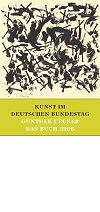Navigationpath: Startseite > Kultur & Geschichte > Kunst im Bundestag > Kunstausstellungen > Günther Uecker - Das Buch Hiob
Günther Uecker: The Book of Job

Günther Uecker signs original prints of his work The Book of Job. © Günther Uecker/Photo:Matti Har-El/Courtesy: Har-El Printers & Publishers, Tel Aviv-Jaffa
Günther Uecker’s The Book of Job is an artist’s book with forty-seven original prints signed by the artist. Each double-page spread consists of an image on one page and the biblical text in Hebrew and Martin Luther’s German translation on the other. The book was produced at the printing studio of Har-El in Jaffa, Tel Aviv, using screen printing in combination with the complex terragraph process, which employs sand as a pigment. The Art Council of the German Bundestag has acquired a copy of this book, a work of equal significance to Christians and Jews, and is displaying it in the Bundestag’s Art Room before it takes up a permanent place in the multi-faith chapel of the Reichstag building.
The Gospel According to Thomas and The Book of Genesis
Two other artist’s books produced at the Har-El studio are also on show, testifying to the concepts and working procedures embraced by this gallery in Jaffa. The books are The Gospel According to Thomas by Jannis Kounellis and The Book of Genesis by Emil Schumacher.
The Book of Job belongs among the most important works of world literature. It addresses one of humankind’s chief existential problems - its idea of God and, in particular, theodicy, the justification of God’s omnipotence and goodness in a world marked by evil, by physical and moral ills. Human happiness and suffering often bear no apparent relation to individual conduct, to the way in which a person acts and thinks. Reflection on such issues automatically leads to the fundamental question as to what kind of life can appear ‘just’ (that is, justified) in the eyes of God. The possibility of justification was central to Luther’s religious thinking, so it is only logical that his German translation of the Book of Job should accompany the Hebrew text in Uecker’s book.
The Trial of Job
The Book of Job can be seen as part of world culture not only in terms of its content, but also with regard to its skilful formal composition. The biblical narrative tells the story of Job, a rich man in the land of Uz who lived an upright and contented life. His happiness suddenly comes to an end when God permits Satan to put his righteousness to the test.
Satan tries Job by robbing him of all his children and herds and by subjecting him to physical affliction. Friends come to console him. In discussions with them he complains that he has been made to suffer although he has done no wrong. In this way he contradicts his righteous friends, who believe he must be guilty in some way and seek to persuade him to admit as much.
Job calls on God to explain the reasons for his suffering, but God rebukes him and responds by disclosing his omnipotence, which allows of no justification or discussion of the reasons for his acts, no questioning of his aims. God thus rejects any assumption of a causal relationship between guilt and suffering.
Crisis of wisdom
Job humbly submits to God’s will and repents his presumption in demanding justification. God forgives Job and doubles his previous wealth. Job eventually dies at the age of 140, ‘old and full of days’.
The Book of Job is among the Old Testament books that present God as a deus absconditus, a ‘hidden God’. Written between 350 and 200 BC, it reflects the ‘crisis of wisdom’ generated in the Mediterranean world by the spread of Greek rationalism, which posed a threat to mythical thinking and shattered belief in a divine justice that was definable and predictable.
Later alterations to the book cannot disguise its core message, which consists in the humble, almost terrifying recognition that God’s will is unquestionable because it forms part of his omnipotence as a being hidden from us.
The essence of God
Günther Uecker has made an artist’s book from this work of literature. Few artists can be better suited to engaging with such demanding subject matter. Uecker ranks among the most highly respected artists in Germany and abroad, and he has repeatedly addressed issues relating to human nature and humankind’s attitudes to creation and creator.
His most important recent works include the multifaith chapel in the Reichstag building, a space that encourages dialogues between religions and embodies a profound theological interpretation of the things that various faiths have in common.
Uecker’s The Book of Job meets the same kind of high theological demands. None of the seventy-four prints relates to the text in an illustrative way: none is a conventional narrative image. Instead, the prints consist of ur-forms and ur-structures. Nail shapes and traces of hands are occasionally recognisable, but otherwise the viewer is confronted with geometrical figures - dots, circles, a triangle, large rectangles and, time and again, a big disc like a powerful whirlwind - and with gestural marks, usually in black and white, but sometimes the colour of sand.The latter consist of real sand, imprinted on the surface using the terragraph technique invented by the Har-El printing studio.
Omnipotence of God
The sand is symbolic. It evokes the deserts of the Middle East, the environment inhabited by biblical narratives, the place where God revealed himself to Moses in the Burning Bush, the wilderness into which Jesus withdrew for forty days to fast and pray. In his Job cycle Uecker has devised compelling visual equivalents to the basic religious tenor of the text: God is someone who cannot, and may not, be imaged in human terms, who resides in primal shapes like a primal force (in the metaphorical, not the deist sense), who is revealed in those shapes and who confronts humanity as a focus of energy, as a circling whirlwind emerging from the weather (as the Book of Job poetically puts it), as a force field embodying his omnipotence.
Anyone familiar with Günther Uecker’s work knows that it reflects physical acts in an immediate way. In a sense, his works are a kind of ‘action art’. Physicality is perceptible in the Job prints as the vigorous, rhythmic motions involved in painting and shaping, as the expression of mental and emotional excitement, of an inner fire. In this way, the prints represent a dramatic staging of the Book of Job, a vitalised encapsulation of spoken addresses and responses, of the desperate laments of Job and the appearances of God.
Forty-seven original prints
Uecker’s images give visible shape to the content of the biblical narrative, to this tale of the omnipotence and mystery of God, of humankind’s wrestling with its idea of God. In Uecker’s prints a book of the Bible becomes a living vision of God, not an image of God.
The Book of Job, forty-seven original prints by Günther Uecker, signed by the artist, on acetates, edition of 99, screen print and terragraph, produced in the studio of Har-El in Jaffa, Tel Aviv, hand-printed by Nissim Ben-Nun, Gilad Margol and Orly Spinzi
Günther Uecker
born in Wendorf, Mecklenburg, in 1930, is based in Düsseldorf and Berlin
Place of exhibition
Art Room of the German Bundestag
11 February to 16 August 2009
Marie-Elisabeth Lüders Building, Schiffbauerdamm, 10117 Berlin
Entrance on the Spree Promenade, on the opposite bank to the Reichstag Building
Opening hours
Tuesday to Sunday from 11 to 17 hrs
Information
Tel.: +49 (0)30 227-32027
kunst-raum@bundestag.de
www.kunst-im-bundestag.de
Published by: German Bundestag
Secretariat of the Art Council
Platz der Republik 1, 11011 Berlin
Text and concept: Andreas Kaernbach, Curator of the German Bundestag's Art Collection
Further information
Further Information
Related Topics
Information Material
-
Flyer: Günther Uecker - The Book of Job


